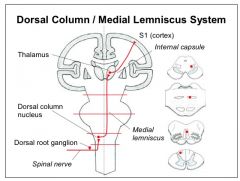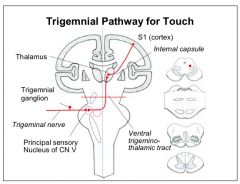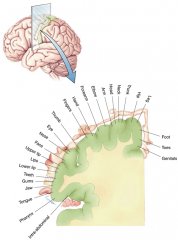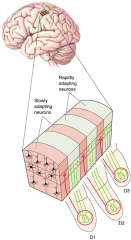![]()
![]()
![]()
Use LEFT and RIGHT arrow keys to navigate between flashcards;
Use UP and DOWN arrow keys to flip the card;
H to show hint;
A reads text to speech;
13 Cards in this Set
- Front
- Back
|
The Touch Pathways:
• The number of neurons involved in the chain, the general trajectory of each and what each synapses on • Two pathways of touch |
The Touch Pathways:
• 3 neuron chain - 1st order neuron: is a somatosensory neuron. Their afferent fibers in peripheral nerves synapse on secondary neurons in the dorsal horn - 2nd order neurons: Its fibers cross the midline and synapse in the thalamus - 3rd order neurons: Their fibers run in the posterior limb of the internal capsule and end in the primary somatosensory cortex • Two pathways for touch - The Dorsal Column/Medial Lemniscus System (The spinal nerve pathway) - The Trigeminal Pathway |
|
|
The Dorsal Column/Medial Lemniscus System:
• The location where the somatosensory pathway for touch and vibration start • The location where the proprioception pathway starts • Describe the trajectory of the 3 neuron chain, the location of their nuclei and specific synaptic sites of each |

The Dorsal Column/Medial Lemniscus System:
• Touch/vibration start on the body surface at the dermatomes • Proprioception starts at the muscles • Three neuron chain - 1st order primary sensory fibers enter the spinal cord through the DRG ganaglion (also the location of their nuclei) of the spinal nerves. Its fibers ascend up the cord ipsilaterally on the cuneate or gracile nuclei of 2nd order neurons in the dorsal column of the lower medulla. Fibers from the 2nd order neurons will cross the body's midline (now contralateral) and ascend in the medial lemniscus The 2nd order neurons synapse in the ventral posterior lateral (VPL) thalamic nucleus, the site of 3rd order neurons. 3rd order neurons from the thalamic nucleus ascend through the limb of the internal capsule and synapse in the primary somatosensory cortex (posterior gyrus of the parietal lobe) |
|
|
The Trigeminal Pathway for Touch:
• Touch/vibration/proprioception uses these receptors on this region of he body • Describe the trajectory of the 3 neuron chain, the location of their nuclei and specific synaptic sites of each |

The Trigeminal Pathway for Touch:
• Uses cutaneous mechanoreceptors and muscle proprioceptors on the face • 1st order neurons are the primary sensory receptor neurons. Their cell bodies are in the trigeminal ganglion 1st order neurons enter the brainstem at the pons and synapse in the nucleus of CN V (location of 2nd order neurons), in the upper half of the pons Fibers of 2nd order neurons decussate to the contralateral site, ascend in the Ventral trigeminothalamic tract and synapse in the VPM thalamic nucleus, the site of 3rd order neurons The fibers of 3rd order neurons travel through the posterior limb of the internal capsule, through the corona radiata andd synapse at the primary somatosensory cortex |
|
|
Based on the Touch Pathways, fibers carrying somatosensory information for touch/vibration/proprioception from the face can only be found in these areas of the brainstem (2)
|
The upper pons and midbrain
|
|
|
The Primary Somatosensory Cortex:
• located in this lobe • forms this gyrus • in a medial view, part of this structure • Its Brodmann's areas |
The Primary Somatosensory Cortex:
• Parietal • Post-central • Paracentral lobule • 3, 1, 2 |
|
|
Explain the general idea behind topographical organization of the sensory cortex
|

Points that are in close proximity to each in reality (on the body) are also close together on the somatotopic map
|
|
|
Describe the columnar organization of S1
|

Each cortical column in the cortex contains all 6 cortical layers
Columns alternate their type of processing input with slowly-adapting and rapidly-adapting receptors |
|
|
Input of cortical layer IV of the primary somatosensory cortex
- name the nuclei, fibers and neurons are involved |
It receives input from the VPL and VPM thalamic nuclei through thalamo-cortical fibers of 3rd order neurons
|
|
|
Two Point discrimination:
• Explain the diff btwn low and high threshold • Name the factors contributing to high spatial resolution |
Two Point discrimination:
• Low threshold indicates the distance btwn two points on a body surface can be relatively low, resulting in 2 points in close proximity still being differentiated as separate. It can also be described as having high spatial resolution • Factors: - high density of cutaneous mechanoreceptors - small receptive fields of the receptors, such as in Merkel's discs and Meissner's corpuscles - Larger cortical area encoding for that particular part of the body - Lateral inhibition and other special mechanisms can improve spatial resolution |
|
|
The first sensation often lost in peripheral neuropathies
|
Vibration
|
|
|
Name 3 neuological examinations to test complex tactile fxns
|
1. Two-point discrimination test
2. Sterognosis 3. Graphesthesia |
|
|
Tabes doralis:
• origin • etiology • Consequence |
Tabes doralis:
• Syphlitic infection • Destruction of DRG cells w/ large diameter axons • Severe deficit in touch and proprioception Slight deficit in nocio- and thermo- sensation |
|
|
Explain the theory for the phantom limb
|
Due to a trauma/injury, the cortical map has been reorganized. Touch pathways that originated in the missing limb will connect with cortical neurons in a neighboring area, leading to new connections in the primary somatosensory cortex
|

